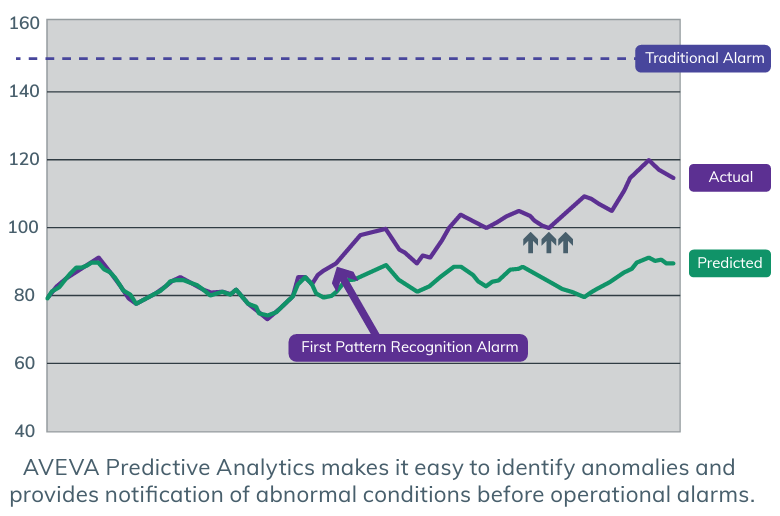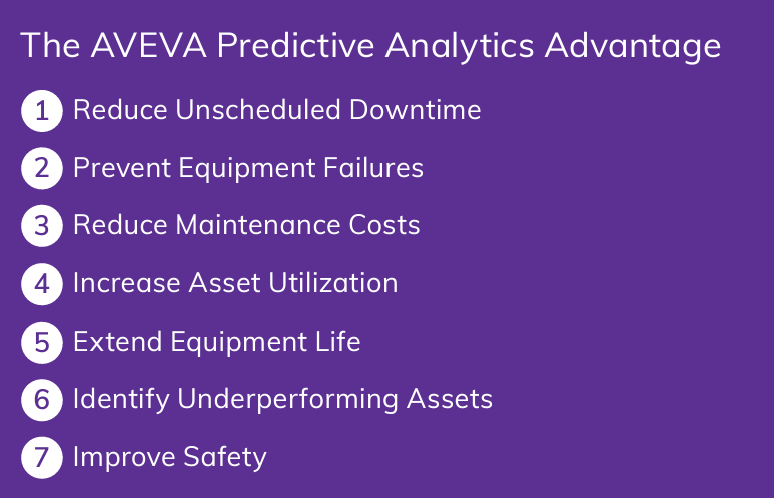AVEVA releases a new version of AVEVA™ Predictive Analytics
Written by Petra Nieuwenhuizen, Product Marketing Manager APM, AVEVA
This May, AVEVA released an updated version of its AI and machine learning software solution, AVEVA Predictive Analytics. The application takes near-real-time asset information compared with equipment history to alert users of deviations from normal operating conditions. It can notify operators when a piece of equipment is performing poorly or is likely to fail. Organizations use it to diagnose equipment issues days, weeks, or months before failure—avoiding unplanned downtime, increasing asset utilization, and helping meet market demands.
AVEVA Predictive analytics uses artificial intelligence, advanced pattern recognition, and sophisticated data mining techniques. Monitor a single asset, a specific plant or thousands of remote assets across hundreds of sites. Our new release of the application incorporates feedback from the largest operators of centralized monitoring centers in the world to make the software deployable, useable, and maintainable at scale.

What’s new in this release?
1. Sensor fault detection. On average, a quarter of all issues detected by AVEVA Predictive Analytics are related to sensor malfunctions, which can take weeks to repair. Our new configurable sensor analysis rules will signal bad sensors and exclude them from calculations and models. Make decisions more confidently when you are certain your results aren’t clouded by sensor malfunctions.
2. Forecasts for Remaining Useful Life Estimation (RULE). If you know when a piece of equipment may fail or reach the end of its life, you can make more informed maintenance decisions. Our new RULE forecasts the time to replace or overhaul an asset under the current operating conditions. The system evaluates the time range and distance to reach a failure threshold (e.g. bearing temperature, filter differential pressure, vibrations), so you can adjust operating conditions or plan maintenance if necessary.
3. Asset Framework adapter for AVEVA™ PI System™. To better leverage an enterprise deployment of AVEVA PI System, this version includes an AVEVA PI System Asset Framework Real-Time Service. The Asset Framework capability identifies tags based on various characteristics or association to templates. For AVEVA Predictive Analytics, the new adapter ensures consistency across multiple assets of the same type, so it reduces model configuration errors. It also drastically improves the maintainability of the system by separating the configuration of AVEVA Predictive Analytics models from the tag deployment in AVEVA PI Servers.
User-friendly analysis industrial organizations already count on
AVEVA Predictive Analytics models clearly identify which sensors deviate from normal conditions, including the magnitude of this deviation for each sensor. The application simplifies fault detection with trends visualization, and we built it to be user-friendly. With the pre-built model templates from our library, model building takes minutes instead of hours, and the models are easy to replicate. Overall, you need less subject matter expertise and domain knowledge to run the application.
We designed the software with the democratization of AI in mind. The new fault diagnostics view facilitates the identification of possible faults in an intuitive visual way, so maintenance and reliability personnel better understand the possible failure modes and provides prescriptive actions to confirm the issue in inspection rounds. With this software, you can reduce your dependency on data scientist specialists to interpret results, which can delay the remediation of equipment issues.

Prescriptive guidance across the enterprise
With labor force shortages and a generation of workers retiring, organizations are seeking digital solutions for meeting work demands. AVEVA Predictive Analytics can help—with prescriptive guidance for anomalies. The new trends and case management integration feature integrates the lessons learned from past anomalies with activities and comments from users in one screen overview. For each fault signature, our library of failure modes provide specific tasks employees can take to mitigate or prevent equipment failure. Workers can log their activities during the course of an alert, and in doing so, create a knowledge base that can be referenced for similar anomalies in the future. The application can become a teaching tool for new recruits or a means of continuous improvement. Track alerts from inception to resolution with the application’s integrated workflow.